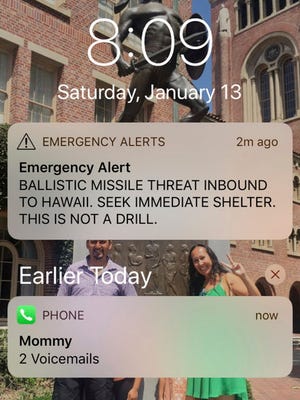Hawaii emergency chief resigns, officer fired over false missile alert
 Aamer Madhani
Aamer Madhani
The head of the Hawaii Emergency Management Agency that earlier this month mistakenly sent an emergency alert warning to residents and media of an incoming missile strike on the state has resigned from his post over the embarrassing episode, state officials announced Tuesday.
In addition to the resignation of the agency leader, administrator Vern Miyagi, the officer who sent the false alert was fired from his post and a second worker quit before disciplinary action could be taken. Another agency officer is being suspended without pay, said Maj. Gen. Joe Logan, Hawaii National Guard adjutant general.
The announcement of the ousters come as the Federal Communications Commission on Tuesday issued preliminary findings detailing how miscommunication between an emergency agency supervisor and an agency employee led to the transmission of a false alert that put the state’s residents on edge for nearly 40 minutes.
The FCC and Hawaii officials also revealed that the agency officer who issued the alert believed that a real attack was imminent when the officer sent out the dire emergency warning to Hawaii residents.
Hawaiians received the false emergency alert notification warning of a ballistic missile threat shortly after 8 a.m. Jan. 13. The alert specifically warned of an inbound missile, urged them to “Seek Immediate Shelter” and underscored that “This Is Not A Drill.”
"Furthermore, when it became apparent the real-world alert was issued, Employee 1 seemed confused, he froze and another employee had to take over his responsibilities," Bruce Oliveira, who conducted the internal investigation for the state, told reporters. "Employee 1 also had a history of confusing drill and real-world events."
Oliveira added that the employee who issued the false alert had been with the agency for at least 10 years. He said that the employee on at least two other occasions confused a drill as a real-life event.
Logan said that the employee who was suspended was charged with making sure agency officials followed protocols for the state's alert system and was charged with updating those protocols as needed.
The state agency conducted a drill earlier that morning that went off without a hitch, but then the night supervisor decided to run another drill without warning during a shift change, according to the FCC report.
Here’s how things went badly awry according to the FCC:
The midnight shift supervisor issued a recording to the day shift supervisors that included the drill language “EXERCISE, EXERCISE, EXERCISE” but also erroneously contained the text “THIS IS NOT A DRILL.” The recording did not follow the script contained in the agency’s standard operating procedure, the report says.
The day shift warning officers received the recorded message on speakerphone. While other warning officers understood it was a drill, the warning officer who issued the alert believed that it was a real emergency and issued the alert, according to a written statement to the state agency from the warning officer.
With two minutes, the state emergency agency notified the governor of the false alert and about 12 minutes later the agency posted on social media accounts that there was no missile threat. But it took 38 minutes before the emergency management agency sent out a correction through its mobile alert system.
“In my view, here are the two most troubling things that our investigation has found so far: Hawaii’s Emergency Management Agency didn’t have reasonable safeguards in place to prevent human error from resulting in the transmission of a false alert; and Hawaii’s Emergency Management Agency didn’t have a plan for what to do if a false alert was transmitted,” FCC chairman Ajit Pai said.
The FCC said the Hawaii agency has already taken steps to try to avoid the mistake being repeated. The agency is now requiring more supervision of drills and alert and test-alert transmissions. It also has created a correction template for false alerts and has put a pause on drills until its own investigation is completed.
Follow USA TODAY's Aamer Madhani on Twitter @AamerISmad